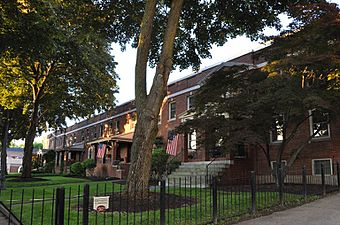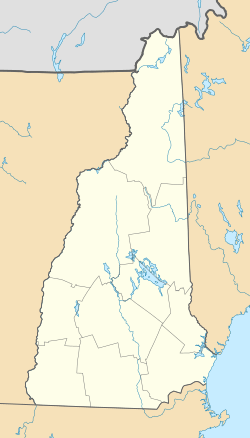District C facts for kids
Quick facts for kids |
|
|
District C
|
|

Front view of a typical rowhouse in the district
|
|
| Location | Roughly bounded by N. Hampshire Lane, Hollis, Canal, and Bridge Sts., Manchester, New Hampshire |
|---|---|
| Area | 5 acres (2 ha) |
| Built | 1881 |
| Architect | Stevens, George |
| MPS | Amoskeag Manufacturing Company Housing Districts TR |
| NRHP reference No. | 82000620 |
| Added to NRHP | November 12, 1982 |
District C is a special historic neighborhood in Manchester, New Hampshire. It is known for its unique rowhouses where factory workers used to live. These homes were built a long time ago by the Amoskeag Manufacturing Company. This company had a huge mill (factory) nearby.
The district is located close to the former Amoskeag mill. It is roughly bordered by N. Hampshire Lane, Hollis, Canal, and Bridge streets. This area was recognized as a historic place on November 12, 1982. It was added to the National Register of Historic Places.
Contents
What is District C?
District C is a rectangular area located east of the old Amoskeag mills. These mills were along the eastern bank of the Merrimack River. The district is also west of Elm Street, which is a main street in the city.
The neighborhood is bordered by Hollis Street to the north and Canal Street to the west. North Hampshire Lane is on its eastern side.
The Homes in District C
Most of the surviving buildings in District C are north of Kidder Street. One building is between Kidder and Bridge Street. Each building in this area is a rowhouse. A rowhouse is a type of home that shares walls with the houses next to it. They are built in a line, like a row.
These homes are about 2½ stories tall. They are made of strong brick. Each rowhouse has four separate living units inside. The roofs are "hip roofs" with dormers, which means they have windows sticking out. The main entrances are often in pairs. They have decorative covers called "Stick style" hoods. At the back of each unit, there is a two-story section with a porch.
History of the Homes
The Amoskeag Company built these homes for its many workers. This was a common practice for large companies back then. They wanted to provide housing close to the factories.
Building in the 1880s
Four of the nine original blocks in District C were built in 1881. They were designed by George Stephens, who was the company's civil engineer. Seven buildings were originally constructed at this time. However, three of them have since been torn down.
Building in the 1910s
The other five buildings in the district were built later, in 1916. These homes were specifically built for the company's "overseers." Overseers were like supervisors or managers in the factory. This group of houses was the last set built by the Amoskeag Company.
In the 1970s, these historic homes were changed into condominiums. This means that each unit became individually owned, rather than being rented from the company.



